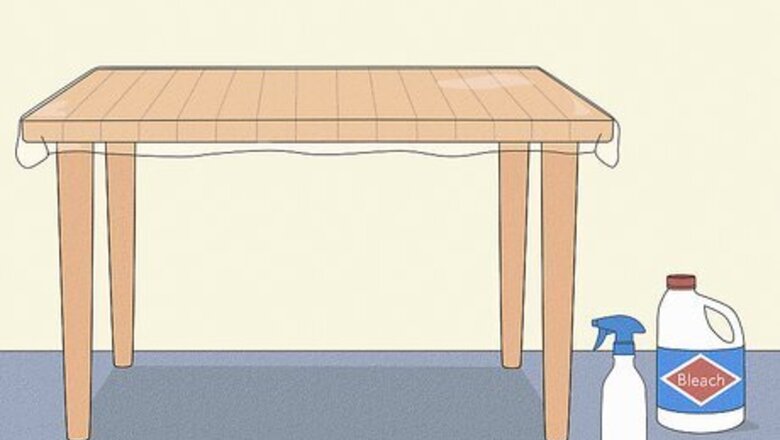
views
Setting Up Your Station
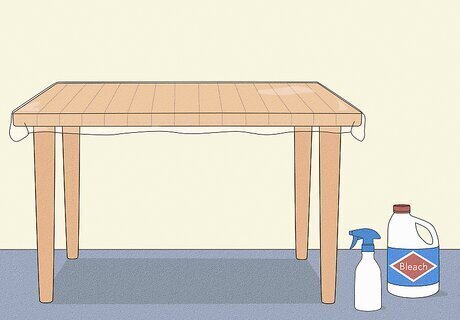
Sterilize your station and cover it in plastic wrap. Wash your hands well and put on a pair of nitrile gloves. Spray a large surface (like a table or desk) with a solution of 4 US tbsp (59 mL) of bleach mixed into 1 US qt (0.95 L) of water, then wipe it down. Spray on more disinfectant, then cover the entire surface in plastic wrap. The moisture helps the plastic wrap stick better.
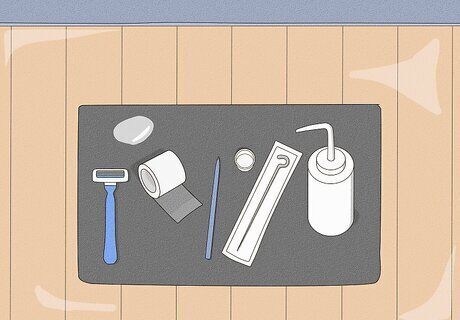
Set up your equipment on a paper towel or dental bib. Put down a dental bib or paper towel on the plastic wrap to catch any spilled ink or blood. Squeeze some Aquaphor on the towel and get out the rest of your materials.

Sterilize your razor, ink caps, and bottle with rubbing alcohol. Put your ink cap and razor into a clean glass, then cover them with rubbing alcohol. Pour rubbing alcohol into your squeeze bottle, slosh it around, then squeeze it out. Wipe down the outside of the bottle with rubbing alcohol or your bleach solution. Some people recommend leaving the ink cap in the rubbing alcohol for at least five minutes, while other tattoo artists just recommend a quick rinse.
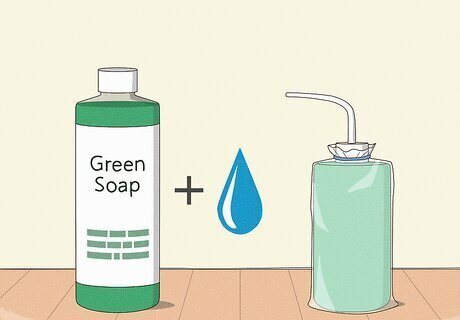
Make your soap solution and wrap your squeeze bottle. Pour some green soap into your squeeze bottle, then either add distilled water to it or prepare a new bottle with distilled water. Wrap the bottle/s in plastic wrap, or put them in a sandwich bag. Wrapping your bottles helps prevent them from getting contaminated with bodily fluids. Avoiding infection and cross-contamination is the most important part of giving tattoos. Tattoo artists use specially formulated “green soap,” which targets proteins, to wash the skin as they tattoo.
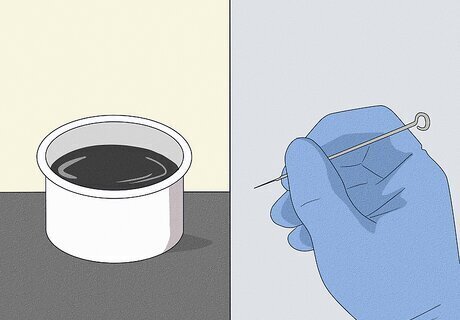
Fill the ink caps and unwrap your needle. Stick the sterile ink cap to the paper towel with some Aquaphor, then fill it to the top with tattoo ink. Put on a new pair of gloves and take a needle out of its sterile packaging. The easiest way to keep things clean is to use a squeeze tube of Aquaphor. If you want to buy a tub instead, take out globs of gel with sterile, single-use tongue depressors—not your fingers. It’s better to take out too much ink than too little. That way you’re less likely to need a refill during the tattoo. If you need a refill, change your gloves before and after touching the tattoo ink bottle. Do not use needles with damaged packaging. Do not touch the needle with your bare hands or gloves that have come in contact with other things.
Preparing Your Skin for the Tattoo
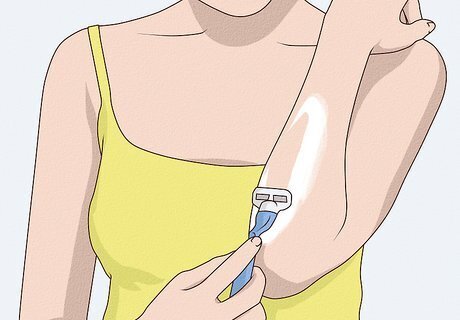
Shave your chosen area and clean it with rubbing alcohol. Wipe down where you want your tattoo with the green soap solution, and shave an area an inch larger than your design with a sterile razor. Then, sterilize your skin by dabbing it with rubbing alcohol. Since you're tattooing yourself, the spot is easy to reach. You may be poking for a few hours, so avoid awkward places like your chest or shoulders. Make sure the rubbing alcohol is evaporated before you continue.
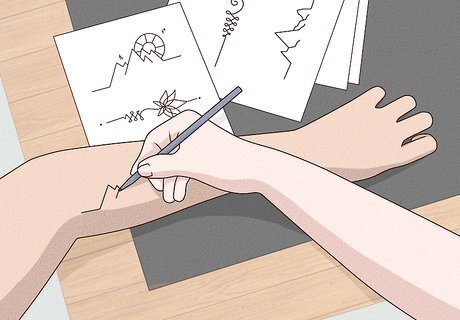
Trace or draw the design onto your skin with a stencil marker. Draw your design directly on your skin with an alcohol-based marker (like a Sharpie) or a stencil marker. Use a light color so you can easily see your lines as you start tattooing. You can also use stencil paper to get a more accurate image. If you use stencil paper, transfer the stencil by rubbing regular Speed Stick deodorant over the area, then laying the stencil flat onto it. If you mess up the stencil, scrub it off with rubbing alcohol and try again. When you first start tattooing, only do small, simple tattoos. While some artists can do large, complicated handpoke tattoos, it takes a long time to build that skill. If you want a large design right now, consider going to a parlor.
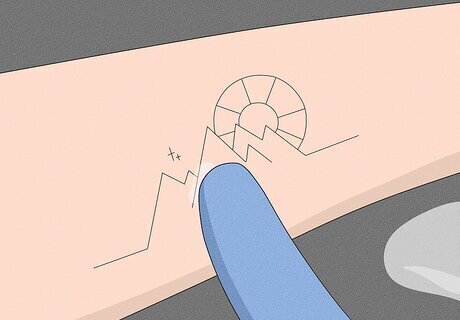
Spread a small amount of Aquaphor over the stencil. Put on gloves, scoop up a little Aquaphor from your paper towel, and put it on the back of your non-dominant hand. Dab a thin layer of it over your design. This keeps the ink from running and covering up your guide. If you use transfer paper, let the stencil dry for at least ten minutes. The gel makes a barrier on the skin which the ink beads up on, making it easier to wipe away as you make multiple passes over the design.
Starting Your Tattoo
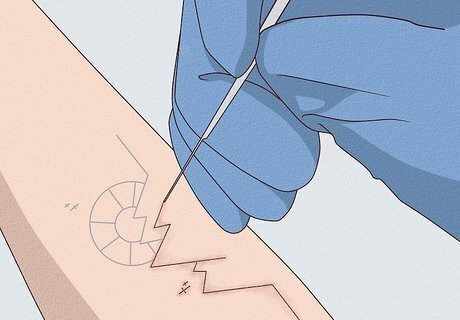
Stretch your skin and poke it at a 45º angle. Use your other hand to stretch your skin in the same direction as the line you’re about to tattoo. Dip the needle into the ink, then poke through your skin at a 45º angle. Listen for a “pop” sound to be sure you’re going deep enough. Stretching the skin gives you control over the line and reduces your chances of making it shaky or wobbly. If you stretch the skin perpendicular to the line you’re poking, then it's more likely to be uneven when you release it. It’s normal to bleed slightly as you go along. If you’re bleeding a lot, however, stop tattooing, resterilize, and hold a clean paper towel over the area until the bleeding stops. You may be going too deep.
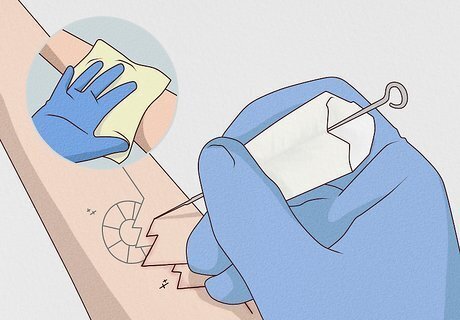
Poke over all of the lines of your stencil. Fill the lines in with tiny dots. To make sure you’re staying in a straight line, never tattoo over running ink. Instead, tattoo where you can clearly see the stencil, wipe it down with green soap and a clean paper towel, then go back over any spot that you missed. Reapply Aquaphor after you wipe it away. Don’t go over the tattoo more than 2 or 3 times. If you overwork the skin it’s more likely to get infected or puffy. If your tattoo ends up spotty, touch it up after it’s totally healed, which could take 1-2 months.
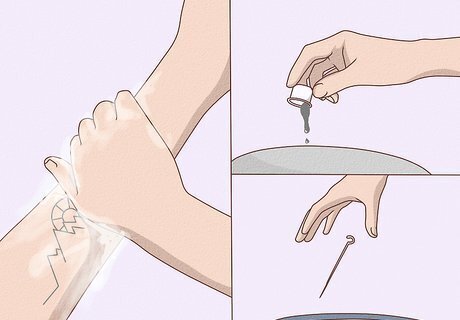
Clean your skin with green soap and break down your station. Squirt green soap into a paper towel and wipe off your finished tattoo. Put your used needle into a sharps container and bring it to a sharps drop-off near you later. Use gloves to throw the used ink, paper towels, and plastic wrap away. Blood is a biohazard, and just throwing away your needles puts waste management workers at risk of infection. The absolute best way to dispose of your trash is to schedule a biowaste pick-up from your trash removal company. Avoid cleaning a fresh tattoo with alcohol -- use soap and water, instead.
Caring for Your Tattoo

Bandage your new tattoo with saran wrap. To avoid infection and cross-contamination, cover your tattoo in plastic wrap for the first few hours. Alternatively, you can use second skin, a sticky bandage that adheres to your tattoo. If you use second skin, keep it on for 24 to 48 hours and remove it under running water, like in the shower. Don't use a cloth or band-aid as they can absorb some of the ink and fade it faster.
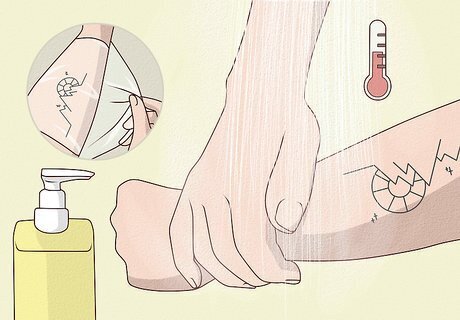
Wash your tattoo with gentle soap after a few hours. To care for your tattoo, tattoo artist Michelle Myles recommends removing the bandage after a few hours and washing your tattoo with mild soap and lukewarm water—“It’s very important to wash the tattoo, maybe even more important than what ointment you apply.” Gently pat and rub the tattoo while you clean it: do not scrub! Don't soak your tattoo or run it under hot water. It won't feel nice, and it takes the ink out of your skin. Avoid picking at the tattoo as this could cause some of the ink to bleed out, causing messy lines and even scarring.

Apply lotion to your tattoo after a day or two. Wait for a scab to form and the swelling to go down, then apply a lotion like Aquaphor or Lubriderm. Myles warns not to “use anything that’s too greasy, like no vitamin E, no aloe, [and] definitely no Vaseline.” Keep the layers thin. Your skin needs to breathe to heal properly. Moisturize your tattoo 3-5 times a day. If your skin starts to look dried out, use a small amount of lotion.
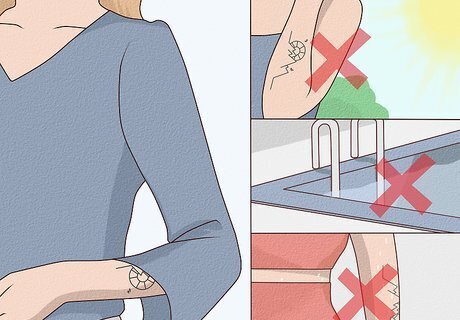
Avoid direct sunlight and submerging your tattoo for 10 days. Don’t swim or take a bath until the tattoo has completely healed, usually about ten days. Tattooed skin is more sensitive to the sun and burns easily, so keep it covered up until it heals, then always put sunblock on it. Avoid excessive sweating, as well. Myles also warns to not pick or scratch at the tattoo, and to wear loose clothing so that nothing rubs up against it. Avoid pools of water such as baths, hot tubs, pools, lakes, oceans, etc. They can cause the ink to bleed in your skin and are full of bacteria, which can lead to infection.
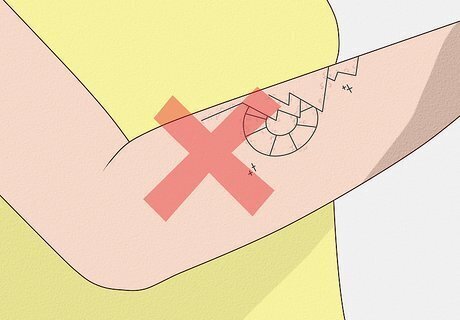
Watch for signs of infection, like excessive irritation. If you have an infection, Myles says “there will be a lot of redness and irritation.” If the tattoo is in an area that bends a lot you may have more irritation than normal, but if it’s excessively painful and red, it may be an infection. You can minimize the risk of infection by keeping your supplies clean and taking care of your tattoo. Still, it's possible your tattoo could become infected. If you suspect that your tattoo has become infected, consult your physician.












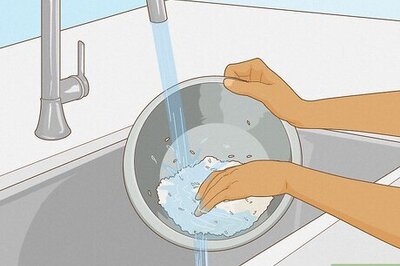


Comments
0 comment